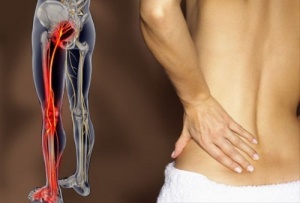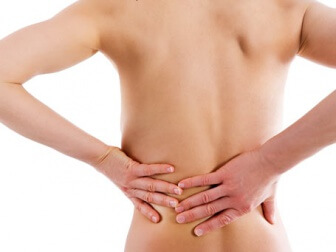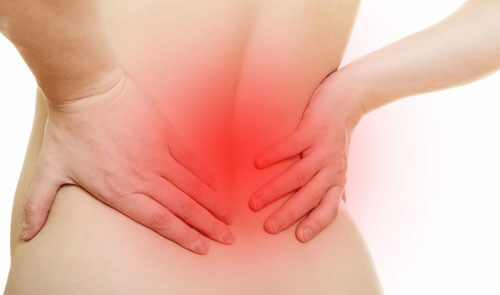How to Treat Sciatica and Lower Back Pain

There are two very similar conditions that cause pain and lack of mobility in the spine. More and more patients are experiencing these problems, either from straining or sitting for long periods without moving. Read more about how to treat sciatica and lower back pain in the following article.
Sciatica: what you need to know
Irritation of the sciatic nerve, more commonly known as “sciatica”, causes pain in the lower back. This pain spreads from the back of the legs and can reach the toes.
This is one of the most frequent problems among adults, especially middle-aged men who have had very sedentary careers. The pain can last for days, weeks or even years, and it significantly restricts freedom of movement.
“Sciatica” occurs when the sciatic nerve becomes compressed due to movement, heavy lifting or simply by keeping the spine in the same position all day long. The roots of this nerve begin in the spinal cord and exit through the vertebrae, down the buttocks and to the outer edges of the feet.
Some of the most frequent causes of sciatica are:
- Hernia of a vertebral disc
- Narrowing of the lumbar canal
- Piriformis syndrome
- Fractures
- Tumors
- Paget’s disease
- Pregnancy
Its symptoms include:
- Pain that varies in intensity with movement
- Impossibility to move freely, for example, getting out of bed, tying shoelaces or lifting something off the ground.
- Changes in skin sensitivity
- Muscle weakness
- Lack of reflexes
- Lameness when walking

Lower back pain: what you need to know
A vast majority of people have suffered from lower back pain at one time or another in their lives. Also called lumbar pain, it’s pain in the torso area, more precisely from where the ribs end to the buttocks.
It’s the main cause of disability in people between the ages of 20 and 45 and tends to intensify with age. The spinal column is made up of different bones (vertebrae) that are separated by discs of cartilage that cushion movement. The vertebrae are also covered in a thin layer of cartilage and are held in place by muscles and ligaments.
The lumbar area is the lower section of the back and consists of 5 vertebrae that connect the chest to the pelvis and legs. It allows us to rotate, move, crouch and lean, and provides the strength for getting up, walking, running and standing. When you’re suffering from lower back pain, any of these movements will cause pain.
Furthermore, there are two types of lower back pain: specific and non-specific. Specific is when the cause of the pain is known, which happens in about 20% of cases. Some of the things that trigger the problem are osteoarthritis (degenerative arthritis), osteoporosis, herniated disc and spinal stenosis.
In non-specific cases, which account for the remaining 80% of cases, the exact cause of pain is unknown. Factors that often trigger lower back pain are heavy lifting, stress, poor posture or psychological factors, among others.
Another classification for lower back pain is based on how long the pain remains: acute (less than 7 days), subacute (7 days to 7 weeks) and chronic (more than 7 weeks).

How can I treat sciatica and lower back pain?
According to traditional Chinese medicine, problems like sciatica and lower back pain affect the kidneys and bladder and are attributed to the excessive consumption of meat, spicy foods and alcohol, among others.
There is a psychological theory that suggests that lower back pain is the somatization of unresolved emotional issues, like the loss of a job, divorce, abandonment, poverty, etc.
But beyond determining the cause of the pain in your back and legs, it’s good to know a few treatments and solutions. The most natural and effective ones are:
Massages
Place some almond oil or Hypericum essential oil in a bowl and mix with equal portions of arnica and rosemary extracts. Massage from the feet up to the legs, to the small of the back. This warms up and relaxes the body. To make it even more effective, continue the massage across the entire body, focusing on the shoulders and neck.
Therapy
In the event that the pain is being caused by an emotional or psychological problem, seek advice from a therapist. This will ease the pain and the patient will be relieved to talk about problems, traumas and fears. Also, with the help of a professional, you will find out how to relieve the emotional tension that your body might be carrying.
Read also: 5 Keys to Overcoming Emotional Suffering
Exercise

Certain types of exercise or disciplines, such as yoga, tai chi, swimming, pilates or water aerobics, can improve lower back pain. It’s always good to exercise until “the body begins to moan,” yet without forcing too much. Don’t forget to warm up and stretch. Finally, always wait to cool down and wear warm clothing to avoid injuries.
You might also like: Simple Exercises to Heal Sciatic Nerve Pain
Stay active
Try to avoid sleeping too much or sitting in the same position for hours. At work, get up and a take a little walk, for example. Also, at home, try taking breaks when watching TV, and find ways to keep moving throughout the day.
Apply heat
If you don’t have anyone to give you massages and don’t have the money for a specialist, a great idea is to place an electric heating pad on the painful area for a half hour while watching television, reading, or talking on the phone.
We hope you’ve enjoyed this article on how to treat sciatica and lower back pain!
All cited sources were thoroughly reviewed by our team to ensure their quality, reliability, currency, and validity. The bibliography of this article was considered reliable and of academic or scientific accuracy.
- Tobón-Marulanda, F. Á., Vallejo-Maya, J., & Toro-Cortés, L. M. (2011). Lesión del nervio ciático: aproximación médico legal. CES Medicina, 25(1), 65-78. https://www.redalyc.org/pdf/2611/261119568007.pdf
- Gelabert-González, M., Serramito-García, R., Aran-Echabe, E., & García-Allut, A. (2007). Resolución espontánea de hernia de disco lumbar. Neurocirugía, 18(2), 138-140. http://scielo.isciii.es/pdf/neuro/v18n2/caso6.pdf
- Verbiest, H. (1980). Stenosis of the lumbar vertebral canal and sciatica. Neurosurgical review, 3(1), 75-89. https://link.springer.com/article/10.1007/BF01644422
- Muñoz Chiamil, S. (2004). Síndrome piriforme: Una controvertida neuropatía por atrapamiento. Rev. Méd. Clín. Condes, 15(2), 58-60. http://bases.bireme.br/cgi-bin/wxislind.exe/iah/online/?IsisScript=iah/iah.xis&src=google&base=ADOLEC&lang=p&nextAction=lnk&exprSearch=401540&indexSearch=ID
- JA, C. C., Del Pino Montes, J., Comella, F. L., JE, B. G., Pérez, G., & Medrano Le Quément, C. (2006). Enfermedad ósea de Paget. https://svreumatologia.com/wp-content/uploads/2013/10/Cap-41-Enfermedad-osea-de-Paget.pdf
- Maslo, P. (2001). Las dolencias de espalda: hernia, lumbago, ciática, tortícoles. Editorial Paidotribo.
- Covarrubias-Gómez, A. (2010). Lumbalgia: un problema de salud pública. Revista mexicana de anestesiología, 33(S1), 106-109. https://www.medigraphic.com/pdfs/rma/cma-2010/cmas101y.pdf
- Truyols Taberner, M., Medinas Amorós, M., Perez Pareja, J., Palmer Pol, A., & Sesé Abad, A. (2010). Emociones negativas en pacientes con lumbalgia crónica. Clínica y Salud, 21(2), 123-140. http://scielo.isciii.es/scielo.php?script=sci_arttext&pid=S1130-52742010000200002
- Furlan, A., Brosseau, L., Imamura, M., & Irvin, E. (2008). Masaje para el dolor lumbar. De La Biblioteca Cochrane Plus. https://www.researchgate.net/profile/Andrea_Furlan2/publication/228391475_Masaje_para_el_dolor_lumbar/links/0c9605349e2855f261000000/Masaje-para-el-dolor-lumbar.pdf
- Hernández, G. A., & Zamora Salas, J. D. (2017). Ejercicio físico como tratamiento en el manejo de lumbalgia. Revista de Salud Pública, 19, 123-128. https://www.scielosp.org/article/rsap/2017.v19n1/123-128/
This text is provided for informational purposes only and does not replace consultation with a professional. If in doubt, consult your specialist.








